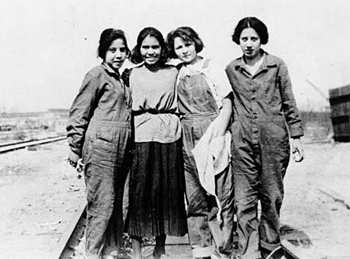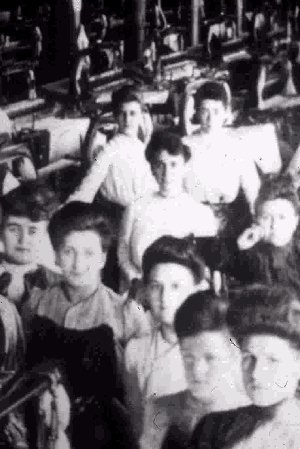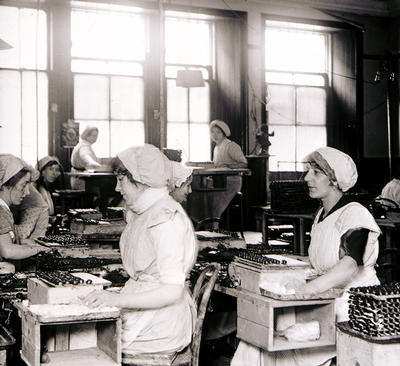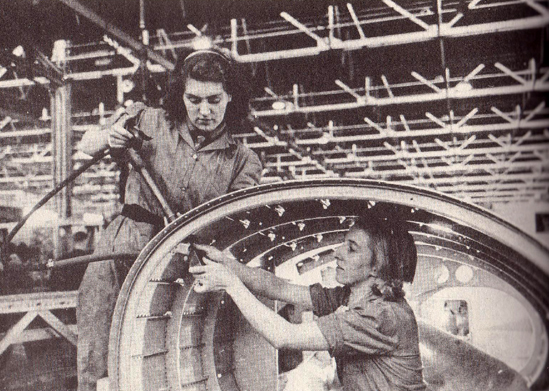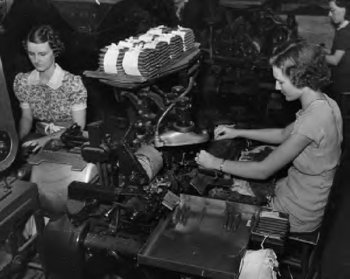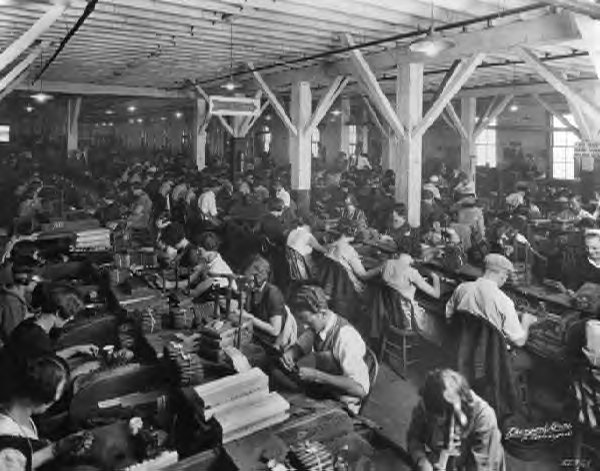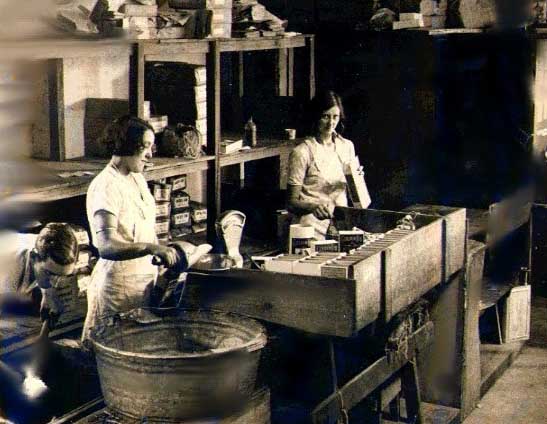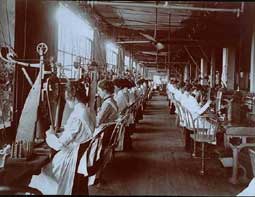 |
||||
|
The Radium Girls' Story
Review by Dr. Sherry Baron Radium Girls: Women and Industrial Health Reform, 1910-1935. by Claudia Clark. Chapel Hill: University of North Carolina Press, 1997. 289 pp, notes and bibliography. $17.95 paper. AT THE BEGINNING of the 20th century a group of young women workers who, while licking their brushes to make a fine point, applied radium-laden paint to the faces of watches and instruments, began to sicken, and in many cases to die. Believing that their work was making them ill, the girls turned to their doctors, then to state health and labor departments, but received little help. Finally they turned to the Consumers League, a reform organization founded by Florence Kelley, the socialist organizer who worked with Jane Addams at Hull House, the famous settlement house in Chicago. Professor Claudia Clark of Central Michigan University was drawn to this story, in part, by her own previous experience as a chemical plant worker. Clark's Radium Girls tells the story of how these young women workers refused to be passive victims. With their middle class female reformer allies, they fought to make the companies take responsibility for the illness and to make the government regulate issues of workers' health. Although the dial painters were just a small group of women workers-between 1917 and 1927 only about 2000 altogether-their plight, Clark argues, became an excellent example of the failures of the philosophy of Progressive Era corporatism or corporate liberalism, where the state's role was to remain a "neutral partner."
In this case, government investigators and scientific experts, beholden to the corporations, were either unresponsive or hostile to the pleas of these suffering women. The Consumers' League's struggle for the radium girls represented a classic case of the struggles for reform at the beginning of the century-against capitalists who deceived their employees, corporate physicians who covered up health problems, state health departments that ignored workers' complaints, and a public which remained ignorant of the important issues involved for the entire society. In this account, Claudia Clark describes the intricate scientific and political process by which radium evolved from being viewed as a wonderfully medicinal element to being recognized as a dangerous toxic material and a cause of occupational disease. Residues from the dial painting studios of the 1920s were reused to make sand for children's sand boxes; when asked about its potential toxicity the company's owner described it as more beneficial than the mud of the world-renowned curative baths. Although primarily a case study in the history of the industrial health movement (today more commonly called the occupational safety and health movement), the book also provides an understanding of the situation of one sector of working class women, and the strengths and weaknesses of one of the major middle class women's social reform organizations of the Progressive Era in the period of World War I.
The Dial Painters' StoryAt age 15, in 1917, Katherine Schaub and her cousin Irene Rudolf had begun working at the dial painting studio of the Radium Luminous Materials Corporation in Orange, New Jersey. They, like the majority of the dial painters, were young women from moderately well-off working class families, largely daughters and wives of skilled and semi-skilled workers. Unlike the image of the squalid sweatshops made famous by the tragic Triangle Shirtwaist fire of 1910, Schaub described the dial painting studio as interesting and of far higher type than the usual factory job. The girls earned between $20-24 per week, which was substantially more than the $15 median wage of New Jersey women at that time. Although the work appeared pleasant, the women were being exposed daily to high levels of dangerous radiation. The dial painting studios were so filled with the dust and residues from the paint that the women's skin and hair actually glowed when they left work. Additionally, in order to provide more precision to their painting, they were instructed to point their paint brushes by drawing them between their lips. In 1922, after working on and off for three years as a dial painter, Rudolf developed a toothache which progressed quickly into an infection and deterioration of her entire jaw. The disease was termed a necrosis, and indeed it proved fatal. Her dentist reported this case to the local health department, which then called in the State Labor Department. An investigation concluded that the jaw problem was associated with exposure to radium, and, although the state investigator suggested that the dial painters be warned of the danger of radium, the state government took no action. Following the report of other cases, a state health officer, Lenore Young, investigated and documented a total of five suspicious cases among the women workers, two of whom had already died. But at the time, she claimed that a lack of time and resources meant she could do no more than report her disturbing findings to the State Labor Department. Later on, Young admitted that she and the City were simultaneously investigating other complaints against the Radium Corporation and that she feared, if the dial painting investigation continued, that there would be no cooperation should she turn to the company for information.
Crusading ReformersSoon afterward, Young asked for a meeting with Katherine Wiley of the New Jersey Consumers' League, telling Wiley that the authorities were hesitating and that the Consumers' League must keep after them. Young's choice of the Consumers' League was an obvious one since during the first decades of the 1900s, the League and other allied social reform organizations had been championing not only women's issues but also industrial health reform. The most famous figure in their crusade was Dr. Alice Hamilton, often considered the mother of the U.S. occupational safety and health movement. As a member of the Hull House community, Hamilton had done pioneering investigations into lead poisoning in Illinois and later went on to document many other industrial exposures and diseases. Florence Kelley, founder of the Consumers' League, was Hamilton's friend and colleague from Hull House and drew her into the League activities. The Consumers' League was joined in its industrial health campaigns by the American Association for Labor Legislation (AALL) which, when founded in 1906, adopted the motto "Social Justice is the Best Assurance Against Social Unrest." Clark explains that the AALL sought to bring labor and management together to prevent the kind of class warfare predicted by Marx and perceived by Americans looking at Europe. Clark notes the prominent role that women reformers from the Consumers' League, the AALL and the Workers' Health Bureau played in promoting industrial health in the 1920s. She supports the view, expressed by the historian Kathryn Kish Sklar, that middle-class women's interest in industrial health came from gender interests which allowed cross-class sympathies to develop. These groups pushed for protective legislation against industrial exposures and diseases for gender and not class reasons, but hoped that eventually this would serve as a wedge to widen political structures that would eventually serve all workers. Additionally, this new generation of college educated, middle-class women reformers found working class health a wide open area not yet dominated by entrenched male professionals. Consequently, as women leaders in a new field they developed a gender analysis intended to improve working class life and thus prevent social unrest.
|
|
|||
|
|
||||
The Fight for CompensationIn 1925, Wiley of the New Jersey Consumers' League was informed by Dr. Hamilton that she would arrange to get herself appointed by the U.S. Bureau of Labor Statistics to come and investigate the cases in Orange, N.J. As she was about to begin this investigation, however, Hamilton discovered that her boss Dr. Cecil Drinker, and his wife Dr. Katherine Drinker, both of Harvard, had investigated the plant the previous year and had concluded that "the trouble...is due to radium." But the company had dismissed these conclusions and the Drinkers had chosen not to release their findings independently without the permission of the company, which had financed their investigation. Furthermore, once Alice Hamilton discovered this she chose to cancel her investigation because of her chief's position in the matter. Eventually, through a series of maneuvers, Wiley and Hamilton forced the release and independent publication of the Drinkers' study and other investigations which conclusively proved the connection between the dialpainting and the women's illnesses. The following year the Consumers' League moved on to support state legislation to make radium poisoning compensable under the state workers' compensation law. However, the final legislation was extremely restrictive, limiting cases to radium necrosis (destruction of the jaw) rather than the more systemic radium poisoning that continued to occur once the lip-pointing brush was eliminated. The law also excluded all cases occurring before 1926, and set a statute of limitations of five months from injury until the time that a claim was filed. This final wording of the legislation, which was supported by the New Jersey Manufacturers' Association, meant that almost no cases would qualify for compensation. Then in 1927, when a young lawyer, Raymond Berry, filed suit for several of the injured workers, the Consumers' League launched a massive and decisive publicity campaign. At one point when the hearings stalled, an editorial in the New York World called the trial "one of the most damnable travesties of justice that has ever come to our attention." Norman Thomas, the Socialist party candidate for president of the United States called it a "vivid example of the ways of an utterly selfish capitalist system." The suit eventually resulted in a settlement when the U.S. Radium Corporation-though never admitting responsibility-was ordered to pay the dialpainters a $15,000 lump sum payment, an annual $600 pension while disabled, and future related medical costs. After winning that case, the Consumers' League continued to crusade in the courts and in state legislatures and the U.S. Congress for young women workers affected by radium poisoning, and to demand laws and regulations to protect the health of other workers. Finally in 1933, the Federal government's Public Health Service laid down guidelines for safe work practices in the production of luminous watches and dials. For the radium girls it was too late.
Reform and Its LimitsClark does an excellent job of showing the weaknesses of the company and state medical investigators, and the economic and political ties which kept them from conscientiously defending worker or public health. Her story also makes clear many of the limitations of the middle-class reform movement and of Progressive Era reformers in general. The Consumers' League, though led by Florence Kelley, herself a socialist and even a Marxist who had corresponded with Friedrich Engels, represented the classic middle-class reform organization of the Progressive Era, of which Hull House was the epitome. In this activity, however, the League -Jane Addams, Ellen Gates Starr, Julia Lathrop and other residents of Hull House, daughters of Republican Party industrialists and political leaders-had become sincerely concerned about the effects of industrialization and urbanization on the lives of the American people. Modeling themselves on British settlement house workers, they decided that concerned citizens had to move into working-class neighborhoods in the cities, where, sharing the experience of workers and the poor, they could begin to remake capitalist society in a more humane way. While the League sincerely wished to defend the "radium girls" and fight to eliminate occupational disease and health hazards from the workplace, its strategy in the struggle was unavoidably shaped by its leadership's middle-class origins and loyalties, and its constructions of female gender differences. As already noted the League and its allies wished to achieve reforms in order to avoid social unrest, attenuate class conflicts and achieve harmony within capitalist society. This was typical of the Hull House approach: Jane Addams, while working closely with unions, sought to help them avoid strikes and worked instead to extend labor arbitration. The League in its fight over the radium issue did not primarily attempt to mobilize unions and workers to take up the women workers' health issues, but turned to middle-class allies concerned about the workplace, hoping to achieve structural reforms in the area of industrial hygiene and workers' compensation. The League's leaders were not only reformers who wanted to ameliorate the situation of workers under capitalism, but also reformists in the Marxist sense of that word, that is reformers who accepted and supported capitalism. The emphasis in the League's work was on litigation, lobbying and legislation, an arena in which workers and labor unions had little power or influence. The method was not particularly to mobilize workers and unions to affect the courts, state legislatures and the Congress, though that formed part of the strategy, but rather to use middle class experts and allies to convince judges and legislators of the legitimacy of the issue and the necessity of social change.
Public Opinion and GenderIn support of its litigation and lobbying, the League also appealed to a particular construction of female gender differences in order to mobilize public, i.e. primarily middle-class sentiment. The League played upon the notion of women as different than men, as wives and mothers, middle-class wives and mothers who had a special role to play in the reform of society, and working class and poor women who easily fell victim to the men who dominated industry, whether as capitalists, factory managers or foremen. The League portrayed the "radium girls" as pathetic victims (which as Clark shows, was not how they viewed themselves). Its strategy for winning public sympathy played upon constructions of gender which, for example, argued that these young women were unlikely to marry, could not bear children or raise families, and would therefore never fulfill a woman's normal and proper role in society. The Consumers' League's approach and its construction of female gender roles represented an alternative to other possible struggles for reform. True enough, in the first decade or two of the century, when the labor movement was dominated by the American Federation of Labor (AFL), then a particularly narrow craft union made up mostly of white male workers, it was not easy to mobilize workers and unions around the health issues of these young women. Yet there was an alternative strategy: workers' self-organization to achieve social reform, a process of self-organization which might lead to more radical social change, and form part of a struggle for socialism. In fact, it was only through such actions as miners' strikes led by the Black Lung Association, and agitation for workers' health led by the Oil, Chemical and Atomic Workers Union, that meaningful workers' health legislation was finally passed in the United States, when in the late 1960s and early `70s Congress adopted the Mine Safety and Health Act (MSHA) and the Occupational Safety and Health Act (OSHA). Yet today we see significant deterioration of these hard won gains as the Federal government adopts more conservative policies and puts emphasis on deregulation and voluntary partnership approaches to occupational safety and health. Once again we need a revitalized movement for workers' health and safety led by labor unions and workers, and working women have a larger role than ever to play in such a movement.
|
||||
 |
|
 |
||
